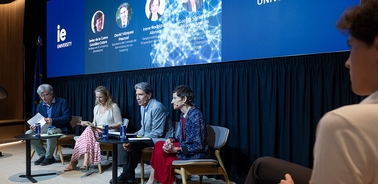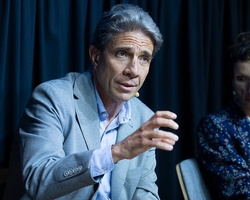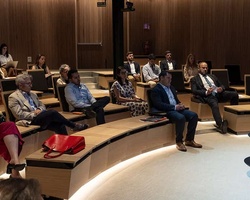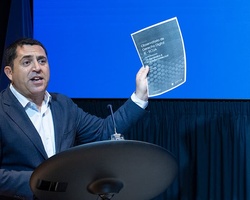- Home
- We Are Law School
- News
- Generative Ai Shakes The Foundations Of Intellectual Property
Generative AI shakes the foundations of intellectual property

The IE-ECIJA Observatory explores in its latest report how GenAI is forcing a rethink of the traditional boundaries of copyright law.
The Generative AI & Intellectual Property report, presented by the IE-ECIJA Digital Law Observatory on June 12, delves into the fundamental challenges that generative artificial intelligence (GenAI) introduces to the legal ecosystem of intellectual property.
Produced through a focus group of leading professionals from the legal and technology sectors, the report emphasizes that intellectual property—traditionally seen as a framework to promote human creativity—is now confronted by an environment in which automated creativity is statistical, predictive, and often untraceable.
The event opened with welcome remarks by Macarena Plaza, Director of International Corporate Development and Legal Innovation at IE Law School, and Carlos Rivadulla, an attorney specializing in intellectual property, industry, and technology at ECIJA. It was followed by a panel discussion moderated by Javier de la Cueva, professor at IE University, which examined critical issues such as the authorship of AI-generated content, the use of copyrighted materials for training purposes, and the growing need for sound governance frameworks to mitigate emerging legal risks.
Loreto Sánchez, Head of Legal Services for Corporate Sustainability and Risk at Iberdrola, emphasized: "We must distinguish between cognitive AI and creative AI. AI is algorithms. The human being must provide the layer of responsibility over data."
Within the corporate sector, the influence of GenAI is already visible. Numerous organizations are deploying these tools in production, marketing, and design workflows—often without well-defined internal protocols to govern usage limits, determine output ownership, or ensure traceability. In this context, the legal function becomes strategically vital for safeguarding intangible assets and preventing potential infringements of third-party rights.
David Vázquez, Secretary of the Board of Directors at Gestamp, cautioned against the use of non-certified AI tools and stressed that "proactivity [on the part of the company] is the best security measure."
The report also notes that GenAI systems are triggered by a human action or prompt, which initiates an opaque (black box) process that produces outputs—whether text, image, code, or sound. Irene Rodríguez, Head of Intellectual Property Legal Affairs at BBVA, pointed out that "creating an internal review committee for all generative AI outputs would be unfeasible."
In its conclusions, the report underscores that internal policies and contractual safeguards constitute a first line of defense against GenAI’s legal risks. However, their effectiveness hinges on the presence of robust governance systems, continuous training initiatives, and a proactive alignment with the evolving regulatory landscape.
Striking the right balance between technological innovation and the protection of creators’ rights will undoubtedly remain one of the defining legal challenges of the coming decade.
About the IE-ECIJA Digital Law Observatory
The IE-ECIJA Digital Law Observatory was established with the purpose of exploring and researching the diverse legal dimensions and implications of the digital economy. The Observatory aims to become a platform for legal and academic research and dissemination within this new legal framework.







